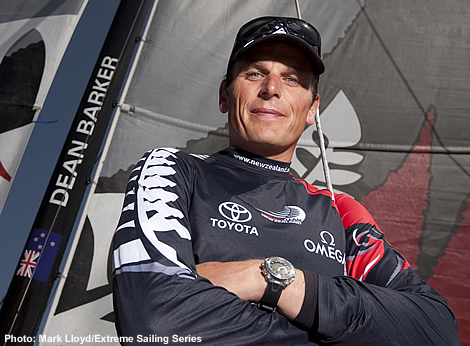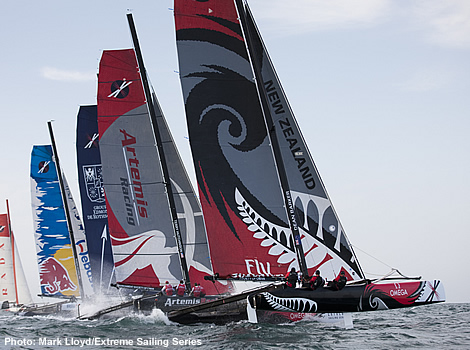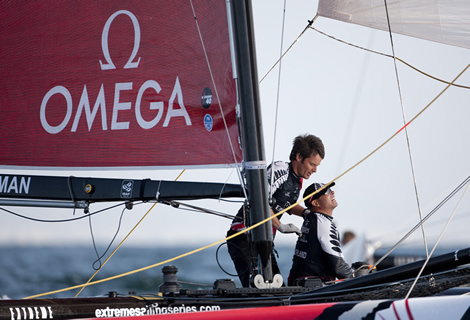
Dean Barker - budding catamaran ace
Emirates Team New Zealand skipper Dean Barker is back on the Extreme Sailing Series this week in Oman, having dipped his toe in at the final event of the season in Almeria last year.
After two days of racing on relatively conventional windward-leewards here off The Wave, Muscat, the Kiwi Cup team is mid-fleet, a position they are unfamiliar with having won the past two Audi MedCup seasons, but a solid step in the right direction on from Almeria where they were decidedly 'finding their feet'.

“We have probably done the least training of all the teams,” admitted Barker to us. “We started down in Auckland and we have been sailing the A-Class and then we got a chance to sail on the AC45, so we decided it was more valuable for us to do that, than spend the extra week here. So we are paying for that at the early part of this regatta. At times we are going well and at other times not so well, but it is good fun.”
Barker points out that all three of his crew have changed since Almeria. Instead of Darren Bundock, the team have employed the services of Bundock’s Olympic Tornado medal winning crew, Glenn Ashby, the multiple A-Class catamaran World Champion, who also coached BMW Oracle Racing prior to their 33rd America’s Cup victory.
On board with Barker, James Dagg is trimming while Jared Henderson was supposed to be here on the bow but sprained his ankle in training, so the equally able Richard Meacham has jumped into his slot. “So it is a completely new team and we are learning again,” continues Barker. “Every day feels better, but we are just missing the little bits and pieces here and there. For the good teams are as you’d expect, that is where they make the games.”
So is he surprised by the standard of competition? “The faces are pretty much the same, although they’ve shuffled around between the boats a little bit. The standard is incredibly high. The racing is great and this type of racing just rewards good team work and I am still learning about positioning around the start line and you just make one little mistake and the next thing is that you aren’t quite at the front of the fleet and then it is hard going battling around in the middle.”
Barker adds that they haven’t had much experience of port tack starts in Extreme 40s, which more teams seem to attempt on this circuit than they do in monohull fleet races. “When it works, it works really well and on the short courses it can be a little bit dicey coming in on port at the top. But the guys that are hanging out there are doing pretty well.”
With the America's Cup moving on to two hulls, so over the last few months, Barker has been learning catamaran sailing and Glenn Ashby has been instrumental to this. Ashby has equipped his skipper with all the necessary A-Class gear... “Glenn being quite handy on the A, he really rates it as a good way to learn the basics of multihull sailing. It teaches you a lot of the finer points. So having done a lot of that has probably helped to feel more comfortable in these [the X40s], and a lot more comfortable than we did in Almeria.”
Impressively in January when Barker took part in the Australian A-Class Nationals, he finished fifth in a fleet of 73, ahead of other familiar names from the Cup world such as Philippe Presti and Noel Drennan.
“I did two or three weeks of sailing on the water before the Nationals, so not a huge amount of time, so I was wrapped, really pleased! I went there with no expectations and upwind I was going really well and had good pace and downwind it was a little bit of a battle, just technique-wise. All in all I was really happy.”
Barker is also one of the few to have sailed in anger on the new AC45 and has some interesting comparisons to make between the brand new one design catamaran and the Extreme 40.
“It is a more modern design so it has quite a lot of different characteristics in terms of manoeuvrability and acceleration [ie it is better in both respects]. It has a lot more volume in the hulls so the boat sits ‘on top of’ the water rather than bearing down, in the hard bear-aways the bows don’t dig in quite the same.”
Through a combination of the wingsail and the greater volume in the hulls (as well as 5ft more LOA), Barker reckons that the AC45 will be the better boat in a breeze. “In 25 knots we’ll see some pretty good racing and by the look of it you’ll be able to sail up-range better than you can in one of these. I think because of the wing and the volume in the hulls they don’t tend to bury or lift the rudders out quite so much, so in a lot of ways it will be better racing.”
While obviously their week on the AC45 was the first occasion the team have had the opportunity to sail with the solid wingsail, Glenn Ashby had fully briefed them following his time with Oracle. “It is interesting - you think it is going to be a big deal, but actually when you get out there it is not. The hard thing is you can’t see through it and you haven’t got the woollies, so the sensation... you very much have to rely on your gut feel and what you believe are the settings.”
Barker says that during the week they were able to train on board they rotated through most of their sailing team, as well as some of their designs. He is distinctly looking forward to sailing them when there are 10 out there racing.
The most wind they saw during their week was 18-20 knots. “It was just getting to that point where you might think you have a bit on, but the boat trims a bit more level and because they have volume forward they don’t tend pitch quite as much so that longitudinal stability and being a bit longer too, they provide a better ride.”
Back to the Extreme Sailing Series and Barker shares his observations: “It is really cool racing. In some ways it is a little bit less tactical, because you lose so much tacking that you don’t tend to take any shifts up the beat. You have got to choose your gate and make sure you’re going the right way and there are a few little options you have at the gate, but after that you are almost forced into winning your side and doing the best you can on it. So it takes away a few of the options after the first lap. There isn’t huge potential to pass and then downwind you don’t seem to do a lot of gybing either because you lose a lot. I think possibly in the 45, because the boats manoeuvre so much better, you’d probably have able to be able to take a few more shifts, but at the end of the day it all comes down to the length of the course.”
And for the first two days the 30 minute races have been relatively conventional. Today the regatta in Muscat goes to a ‘stadium racing’ format, with racing closer to the shore, regardless of the wind direction. “Compared to what we have for the next three days these are long distance courses! I’d imagine they will become a lot more congested, so that it where the good teams that have got the time in these things will come into their own.”













Latest Comments
Add a comment - Members log in